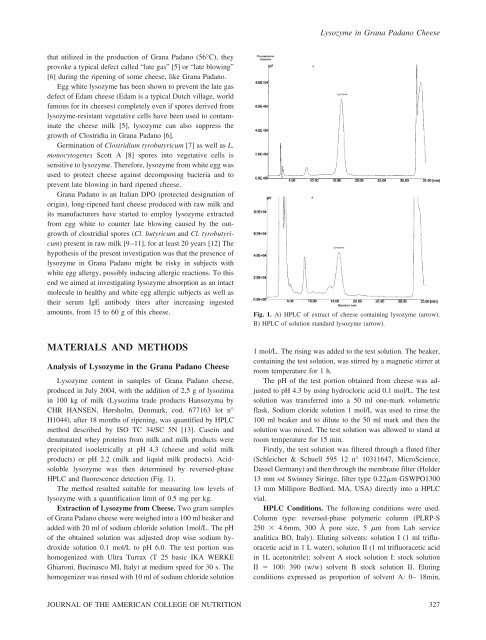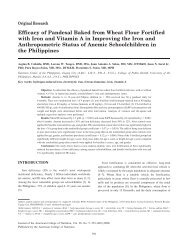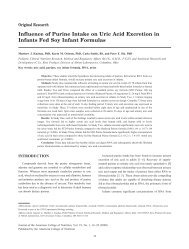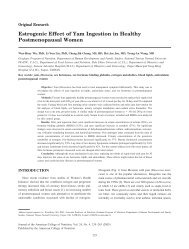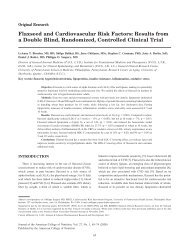Absence of Allergic Reactions to Egg White Lysozyme Additive in ...
Absence of Allergic Reactions to Egg White Lysozyme Additive in ...
Absence of Allergic Reactions to Egg White Lysozyme Additive in ...
You also want an ePaper? Increase the reach of your titles
YUMPU automatically turns print PDFs into web optimized ePapers that Google loves.
that utilized <strong>in</strong> the production <strong>of</strong> Grana Padano (56°C), they<br />
provoke a typical defect called “late gas” [5] or “late blow<strong>in</strong>g”<br />
[6] dur<strong>in</strong>g the ripen<strong>in</strong>g <strong>of</strong> some cheese, like Grana Padano.<br />
<strong>Egg</strong> white lysozyme has been shown <strong>to</strong> prevent the late gas<br />
defect <strong>of</strong> Edam cheese (Edam is a typical Dutch village, world<br />
famous for its cheeses) completely even if spores derived from<br />
lysozyme-resistant vegetative cells have been used <strong>to</strong> contam<strong>in</strong>ate<br />
the cheese milk [5], lysozyme can also suppress the<br />
growth <strong>of</strong> Clostridia <strong>in</strong> Grana Padano [6].<br />
Germ<strong>in</strong>ation <strong>of</strong> Clostridium tyrobutyricum [7] as well as L.<br />
monocy<strong>to</strong>genes Scott A [8] spores <strong>in</strong><strong>to</strong> vegetative cells is<br />
sensitive <strong>to</strong> lysozyme. Therefore, lysozyme from white egg was<br />
used <strong>to</strong> protect cheese aga<strong>in</strong>st decompos<strong>in</strong>g bacteria and <strong>to</strong><br />
prevent late blow<strong>in</strong>g <strong>in</strong> hard ripened cheese.<br />
Grana Padano is an Italian DPO (protected designation <strong>of</strong><br />
orig<strong>in</strong>), long-ripened hard cheese produced with raw milk and<br />
its manufacturers have started <strong>to</strong> employ lysozyme extracted<br />
from egg white <strong>to</strong> counter late blow<strong>in</strong>g caused by the outgrowth<br />
<strong>of</strong> clostridial spores (Cl. butyricum and Cl. tyrobutyricum)<br />
present <strong>in</strong> raw milk [9–11], for at least 20 years [12] The<br />
hypothesis <strong>of</strong> the present <strong>in</strong>vestigation was that the presence <strong>of</strong><br />
lysozyme <strong>in</strong> Grana Padano might be risky <strong>in</strong> subjects with<br />
white egg allergy, possibly <strong>in</strong>duc<strong>in</strong>g allergic reactions. To this<br />
end we aimed at <strong>in</strong>vestigat<strong>in</strong>g lysozyme absorption as an <strong>in</strong>tact<br />
molecule <strong>in</strong> healthy and white egg allergic subjects as well as<br />
their serum IgE antibody titers after <strong>in</strong>creas<strong>in</strong>g <strong>in</strong>gested<br />
amounts, from 15 <strong>to</strong> 60 g <strong>of</strong> this cheese.<br />
MATERIALS AND METHODS<br />
Analysis <strong>of</strong> <strong>Lysozyme</strong> <strong>in</strong> the Grana Padano Cheese<br />
<strong>Lysozyme</strong> content <strong>in</strong> samples <strong>of</strong> Grana Padano cheese,<br />
produced <strong>in</strong> July 2004, with the addition <strong>of</strong> 2,5 g <strong>of</strong> lysozima<br />
<strong>in</strong> 100 kg <strong>of</strong> milk (Lysozima trade products Hansozyma by<br />
CHR HANSEN, Hørsholm, Denmark, cod. 677163 lot n°<br />
H1044), after 18 months <strong>of</strong> ripen<strong>in</strong>g, was quantified by HPLC<br />
method described by ISO TC 34/SC 5N [13]. Case<strong>in</strong> and<br />
denaturated whey prote<strong>in</strong>s from milk and milk products were<br />
precipitated isoeletrically at pH 4.3 (cheese and solid milk<br />
products) or pH 2.2 (milk and liquid milk products). Acidsoluble<br />
lysozyme was then determ<strong>in</strong>ed by reversed-phase<br />
HPLC and fluorescence detection (Fig. 1).<br />
The method resulted suitable for measur<strong>in</strong>g low levels <strong>of</strong><br />
lysozyme with a quantification limit <strong>of</strong> 0.5 mg per kg.<br />
Extraction <strong>of</strong> <strong>Lysozyme</strong> from Cheese. Two gram samples<br />
<strong>of</strong> Grana Padano cheese were weighed <strong>in</strong><strong>to</strong> a 100 ml beaker and<br />
added with 20 ml <strong>of</strong> sodium chloride solution 1mol/L. The pH<br />
<strong>of</strong> the obta<strong>in</strong>ed solution was adjusted drop wise sodium hydroxide<br />
solution 0.1 mol/L <strong>to</strong> pH 6.0. The test portion was<br />
homogenized with Ultra Turrax (T 25 basic IKA WERKE<br />
Ghiaroni, Buc<strong>in</strong>asco MI, Italy) at medium speed for 30 s. The<br />
homogenizer was r<strong>in</strong>sed with 10 ml <strong>of</strong> sodium chloride solution<br />
<strong>Lysozyme</strong> <strong>in</strong> Grana Padano Cheese<br />
Fig. 1. A) HPLC <strong>of</strong> extract <strong>of</strong> cheese conta<strong>in</strong><strong>in</strong>g lysozyme (arrow).<br />
B) HPLC <strong>of</strong> solution standard lysozyme (arrow).<br />
1 mol/L. The ris<strong>in</strong>g was added <strong>to</strong> the test solution. The beaker,<br />
conta<strong>in</strong><strong>in</strong>g the test solution, was stirred by a magnetic stirrer at<br />
room temperature for 1 h.<br />
The pH <strong>of</strong> the test portion obta<strong>in</strong>ed from cheese was adjusted<br />
<strong>to</strong> pH 4.3 by us<strong>in</strong>g hydrocloric acid 0.1 mol/L. The test<br />
solution was transferred <strong>in</strong><strong>to</strong> a 50 ml one-mark volumetric<br />
flask. Sodium cloride solution 1 mol/L was used <strong>to</strong> r<strong>in</strong>se the<br />
100 ml beaker and <strong>to</strong> dilute <strong>to</strong> the 50 ml mark and then the<br />
solution was mixed. The test solution was allowed <strong>to</strong> stand at<br />
room temperature for 15 m<strong>in</strong>.<br />
Firstly, the test solution was filtered through a fluted filter<br />
(Schleicher & Schuell 595 12 n° 10311647, MicroScience,<br />
Dassel Germany) and then through the membrane filter (Holder<br />
13 mm sst Sw<strong>in</strong>ney Sir<strong>in</strong>ge, filter type 0.22�m GSWPO1300<br />
13 mm Millipore Bedford, MA, USA) directly <strong>in</strong><strong>to</strong> a HPLC<br />
vial.<br />
HPLC Conditions. The follow<strong>in</strong>g conditions were used.<br />
Column type: reversed-phase polymeric column (PLRP-S<br />
250 � 4.6mm, 300 Å pore size, 5 �m from Lab service<br />
analitica BO, Italy). Elut<strong>in</strong>g solvents: solution I (1 ml trifluoracetic<br />
acid <strong>in</strong> 1 L water), solution II (1 ml trifluoracetic acid<br />
<strong>in</strong> 1L ace<strong>to</strong>nitrile); solvent A s<strong>to</strong>ck solution I: s<strong>to</strong>ck solution<br />
II � 100: 390 (w/w) solvent B s<strong>to</strong>ck solution II. Elut<strong>in</strong>g<br />
conditions expressed as proportion <strong>of</strong> solvent A: 0– 18m<strong>in</strong>,<br />
JOURNAL OF THE AMERICAN COLLEGE OF NUTRITION 327


